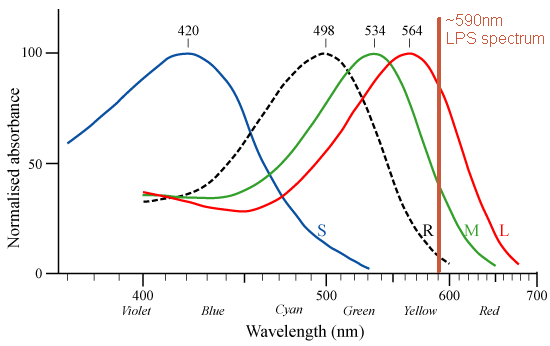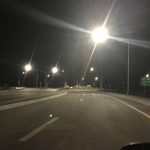Noticed an article about color vision this morning: The Red and Green Specialists: Why Human Colour Vision Is so Odd. This article, and re-reading some of my bookmarks, helped me better understand why red and orange lights are especially useful for humans at night, and why blue-white LEDs are fundamentally defective when used outside.
tl/dr: Most humans have three proteins in their eyes that vary in sensitivity to the different colors of light (some have two-color vision, others have four-color vision). Our peripheral vision is highly sensitive to green/cyan/blue light. Our eyes’ most red-sensitive protein (red line, graph below) is highly sensitive to the orange light emitted by a low pressure sodium bulb. The second-most red-sensitive protein (green line) is less sensitive to orange light. The protein sensitive to blue light is not at all activated by orange light (blue line).

Long ago the lighting industry figured out that Low Pressure Sodium [LPS] bulbs are ideal for outdoor lighting at night. Of the various light bulbs, LPS bulbs are the most energy-efficient of all (lumens per watt). The orange light emitted by these bulbs is good enough to help humans avoid obstacles, but not so good for color photography or security cameras. I added the orange line to the graph above to show how the LPS bulb’s spectrum interacts with our eyes’ light reception proteins.
Low-light vision is most-attuned to green/cyan/blue light. Rhodopsin is the protein that our eyes use for low-light vision. Rhodopsin rapidly degrades when it is exposed to green/cyan/blue light; it is slightly sensitive to yellow/orange light. Humans rapidly lose their low-light vision when exposed to green/cyan/blue light. After losing our night vision, it takes about 30 minutes to fully recover enough rhodopsin to for us to see as well as we possibly can in low-light scenarios.
Protecting night adaptation
It takes about 30 minutes to fully adapt to low-light conditions. Ambient light (moonlight, skyglow) prevent most people’s eyes from fully adapting to low-light conditions. Because rhodopsin is not sensitive to red light and less-sensitive to orange light, using red/orange light preserves rhodopsin for a more-rapid recovery of low-light vision.
Good outdoor lighting
Good outdoor lighting uses light sources that do not emit any blue/green light. Red and Orange LEDs, or Low Pressure Sodium bulbs, are ideal. High Pressure Sodium [HPS] bulbs are okay. HPS bulbs have a little yellow/green/blue light.
Defective outdoor lighting
Streetlights and area lights that emit green/cyan/blue light, in areas where the light is a single light source in the night’s ocean of darkness, are fundamentally defective if humans passing by are expected to be directly exposed to that light source.
Unless a whole area can be brightly lit up (outdoor sports stadium, retail environment with diffuse bulbs placed out of our direct line of sight), lighting should be designed for low-light vision, using red or orange light sources. This is especially the case if the area cannot be lit without directly exposing people to the light source (parking lots, etc).
Dark sky advocates promote using light fixtures that are fully-shielded. These designs allow for light to be directed down, and protect people from the source of the light. Warm-white (2700K) and Amber (2000K/2200K) light sources can be safely used in fully-shielded outdoor light fixtures, if the fixture can be mounted to completely prevent most people from being directly exposed to the source of light.
Amber LEDs (<2200K) could conceivably be used for parking lot lighting, if the fixture was designed to properly diffuse the light. Light has to be diffused to prevent our eyes from getting overloaded.
Sticking a LED high on a pole, even if it’s pointed down, is an annoyance and hazard to the humans who are using that area.
Conclusion
In the 21st Century’s mad rush for energy efficiency, we’ve forgotten what our predecessors figured out about how to use artificial lights safely. The replacement of safe and effective lighting solutions with defective energy-efficient lighting is a mistake. We should all make an effort to let decision makers know that we do not appreciate this particular crime against the public’s health.
Links and selected quotes
Cones vs. Rods
Cone cells have the various Photopsin photoreceptor proteins, and are responsible for color perception. Rod cells are photoreceptor cells in the retina of the eye that can function in less intense light than cone cells. Rods are more responsible for peripheral vision and low-light vision, and have more of the rhodopsin pigment.
Sensitivity of Rod cells vs. cone cells
A rod cell is sensitive enough to respond to a single photon of light[11] and is about 100 times more sensitive to a single photon than cones. Since rods require less light to function than cones, they are the primary source of visual information at night (scotopic vision). Cone cells, on the other hand, require tens to hundreds of photons to become activated.
https://en.wikipedia.org/wiki/Rod_cell#Sensitivity
Understanding the change in human color vision sensitivity from photopic to mesopic and scotopic is essential for proper planning when designing lighting for roadways.
https://en.wikipedia.org/wiki/Sodium-vapor_lamp#High-pressure_sodium
Photopic vision is the vision of the eye under well-lit conditions (luminance level 10 to 108cd/m2). In humans and many other animals, photopic vision allows color perception, mediated by cone cells, and a significantly higher visual acuity and temporal resolution than available with scotopic vision.
Mesopic vision is a combination of photopic vision and scotopic vision in low but not quite dark lighting situations.[1] Mesopic light levels range from luminances of approximately 0.001 cd/m2 to 3 cd/m2. Most night-time outdoor and traffic lighting scenarios are in the mesopic range.[2]
Scotopic vision is the vision of the eye under low-light levels. The term comes from Greekskotos, meaning “darkness”, and -opia, meaning “a condition of sight”.[1] In the human eye, cone cells are nonfunctional in low visible light. Scotopic vision is produced exclusively through rod cells, which are most sensitive to wavelengths of around 498 nm (green–blue) and are insensitive to wavelengths longer than about 640 nm (reddish orange). This condition is called the Purkinje effect.
Sodium Vapor Lamps – Peak at 589nm and 589.56nm
Photopsin – “the photoreceptor proteins found in the cone cells of the retina that are the basis of color vision”.
Different opsins differ in a few amino acids and absorb light at different wavelengths as retinal-bound pigments.
| Cone type | Name | Range | Peak wavelength[1][2] |
|---|---|---|---|
| S (OPN1SW) – “tritan”, “cyanolabe” | β | 400–500 nm (violet->Green) |
420–440 nm |
| M (OPN1MW) – “deutan”, “chlorolabe” | γ | 450–630 nm (blue ->Red- Orange) |
534–545 nm |
| L (OPN1LW) – “protan”, “erythrolabe” | ρ | 500–700 nm (Green -> Deep red) |
564–580 nm |
The loss of color perception in low light
The Purkinje effect (sometimes called the Purkinje shift) is the tendency for the peak luminance sensitivity of the eye to shift toward the blue end of the color spectrum at low illumination levels as part of dark adaptation.
Physiology
The Purkinje effect occurs at the transition between primary use of the photopic (cone-based) and scotopic (rod-based) systems, that is, in the mesopic state: as intensity dims, the rods take over, and before color disappears completely, it shifts towards the rods’ top sensitivity.[9]
The effect occurs because in mesopic conditions the outputs of cones in the retina, which are generally responsible for the perception of color in daylight, are pooled with outputs of rods which are more sensitive under those conditions and have peak sensitivity in blue-green wavelength of 507 nm.
Use of red lights
The insensitivity of rods to long-wavelength light has led to the use of red lights under certain special circumstances – for example, in the control rooms of submarines, in research laboratories, aircraft, or during naked-eye astronomy.[10]
Under conditions where it is desirable to have both the photopic and scotopic systems active, red lights provide a solution. Submarines are well lit to facilitate the vision of the crew members working there, but the control room must be lit differently to allow crew members to read instrument panels yet remain dark adjusted. By using red lights, or wearing red goggles, the cones can receive enough light to provide photopic vision (namely the high-acuity vision required for reading). The rods are not saturated by the bright red light because they are not sensitive to long-wavelength light, so the crew members remain dark adapted.[11] Similarly, airplane cockpits use red lights so pilots can read their instruments and maps while maintaining night vision to see outside the aircraft.
Rhodopsin (also known as visual purple) is a light-sensitive receptor protein involved in visual phototransduction. It is named after ancient Greek ῥόδον (rhódon) for rose, due to its pinkish color, and ὄψις (ópsis) for sight.[5] Rhodopsin is a biological pigment found in the rods of the retina and is a G-protein-coupled receptor (GPCR). It belongs to opsins. Rhodopsin is extremely sensitive to light, and thus enables vision in low-light conditions.[6] When rhodopsin is exposed to light, it immediately photobleaches. In humans, it is regenerated fully in about 30 minutes, after which rods are more sensitive.[7]
… Rhodopsin of the rods most strongly absorbs green-blue light and, therefore, appears reddish-purple, which is why it is also called “visual purple”.[12] It is responsible for monochromatic vision in the dark.[7]
